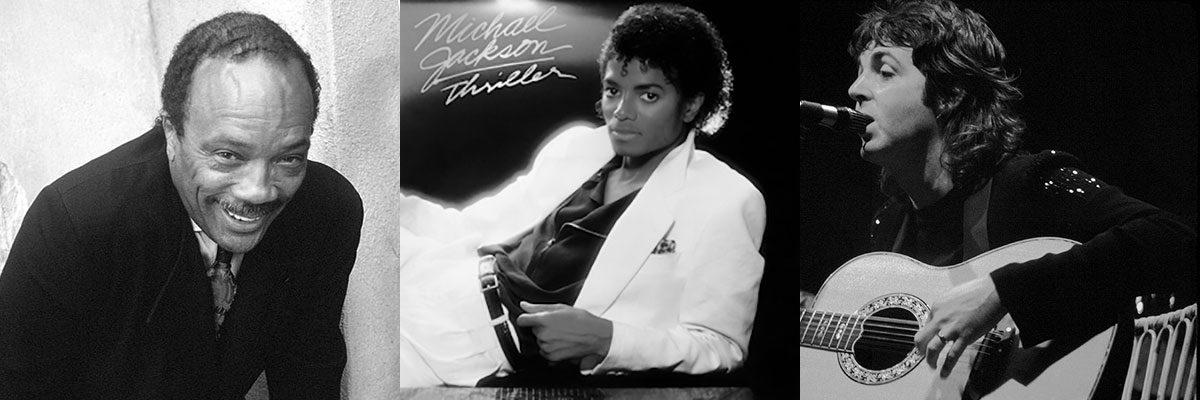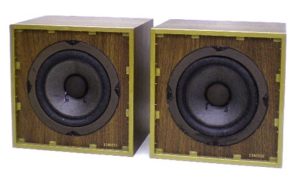The World’s Top Selling Album Was Mixed on “Pathetic” Speakers

Because you have to be where your customers are …
On a cool Wednesday morning in April of 1982, Michael Jackson and Quincy Jones showed up at Westlake Recording Studios in Los Angeles to tape a new song with Paul McCartney. It was the opening session for what was to become the biggest selling album of all time — Thriller.
Both Jackson and Jones were still basking in the glory (and money) of their previous smash album Off the Wall, and Studio A at Westlake, with its Neve console and soundproof piano room, suited their budget of three quarters of a million dollars.
But when it came time to mix the tracks into songs, engineer Bruce Swedian switched off Westlake’s state-of-the-art monitors and did the bulk of his mixing while listening to the tunes through a small pair of inexpensive one-way speakers. And he had the artist’s and producer’s blessing. “Quincy calls them the Truth Speakers,” he said.

Both Jones and Jackson were determined to outdo their last performance on Off the Wall. Michael said he wanted to make the best selling record in history, which he did, and Quincy said he wanted to “save the recording industry,” and apparently meant it.
So with those ambitions, and their lavish budget, why mix through a couple of Auratone 5Cs instead of the studio’s world-class monitors?
According to studio engineer Mike Senior, who interviewed Swedian for an article about the recording of Thriller in 2009, the answer is simple: “Clearly, [an] Auratone won’t impress any of your clients with its pathetic honky sound, but it… ruthlessly spotlights midrange balance and mono-compatibility issues in your mix.”
In other words, it ensures that the essential midrange frequencies are mixed perfectly, giving the mix a solid backbone. And it helps you avoid problems when the music is played through a system that doesn’t have strong bass or treble, or project a clear stereo image. Which is to say, it clues you in to what the record is going to sound like when people hear it played through average home stereos, or over public PA systems, or at school dances, or in car radios, or in short, in most of the situations all over the world where people are actually going to be hearing the songs.

Swedian was not the first to use this trick. In fact, two decades earlier, a former radio host and truck driver named Buck Owens literally had his engineers mixing through car speakers to craft records that practically leapt out of AM radios, even at low volume. Those distinctive twangy tracks not only shot him to the top of the charts but also created a whole new sound in country music, called the “Bakersfield sound” after the city where Owens lived.
Today it’s not uncommon for engineers to check mixes in their cars, or while standing in another room, or even through a pair of old external computer speakers before giving the nod. In my home studio, I have a little unported mono speaker up on the wall, a black box that looks like the kind you see on back patios and decks.
Where Are Your Customers’ Shoes?
Here’s the thing — it’s not enough to put yourself in your customer’s shoes. You have to know where those shoes are standing.
If you’re not interacting with your product in the way your customers are, then you don’t really understand your product. Same goes for your marketing materials.
I’m one of the very few people who drive around actually paying attention to billboards. And I cannot possibly tell you how much wasted money I see pasted to the sides of the highway on a daily basis.
Invisible company names, unreadable URLs, unrecallable phone numbers, illegible white-on-azure fonts. You’d think nobody in their right mind would pay for advertising like that. But people do because they fail to view it as their target audience will see it — from a hundred yards away for a split second while moving at a mile a minute.
If you’d like to see excellence in outdoor advertising, come to Atlanta and check out Chick-fil-A’s billboards. Huge logo, instantly recognizable cow mascots, a single short phrase in an enormous font, maybe an address and that’s it, usually on a monochrome background. For a company that relies on people driving up and buying ready-to-eat food, it’s a perfect ad spend.
But to evaluate a billboard design, don’t sit and stare at it on a screen or a table top and ponder over it. Print it on a sheet of office paper, tape it to the wall, then stand across the room and glance at it for one second. Then ask yourself if you’ll remember it and be able to act on it 20 minutes from now when you’re somewhere else. If the answer is no, change your design.
Same with envelopes — too many clients want to sell on the envelope. Well, if you’re going to do that, save your money and mail a postcard. If your offer demands a mailer, the envelope should be designed to do exactly two things, other than keep its contents off the sidewalk, and that is to get itself opened and to put the reader in a receptive mindframe for what’s inside.
One of my best envelope controls had a single 9-word sentence on it: The big banks hope you throw this envelope away. (A variation on a well worn theme.)
Remember, your postal customers are coming in from the mailbox, sorting through bills and ads and maybe a magazine or the HOA newsletter, probably while standing next to a bin full of paper and plastic where your mailer is about to end up if the envelope can’t convince them to stop and see what’s inside. Ideally, you want them to toss everything except your envelope and the bills and subscriptions, then decide to check out what you have to say before dealing with anything else.
What Is This Doing Here?
When evaluating your creative team’s work, always imagine your customer interacting with the material in the real-world place and time where it’s going to be encountered. Then ask yourself, “What does this piece need to do?” Because all our marketing should have a purpose, some response that we’re inviting from our audience.
Once you do this, the analysis stops being about elements in a design on a desktop, and becomes focused on the customer, and on whether the message is right for that person in that place at that moment.
Responsive design is taking this idea to real-time interactions. Retailers can now send out mobile messages which automatically opt for variations on the message depending on external events. A customer walking near a store on a sunny day gets an offer for sunglasses, while another customer opening the same email blast in another city where it’s raining gets an offer on umbrellas.
You don’t have to go that far, but if you want to make sure you get maximum response to your message, don’t forget to ask where your marketing is going to be when your audience finds it, and to evaluate it from that perspective. You may not rack up the millions of conversions that Jackson and Owens got, but you’re guaranteed to make fewer mistakes in your marketing decisions.
Header image: Montage of images of Quincy Jones (1989) by Gorup de Besanez, Michael Jackson’s Thriller album cover (promotional, courtesy of Epic), and Paul McCartney (1979) by Jim Summaria, all via Wikimedia Commons
Read every story from Paul Thomas Zenki (and thousands of other writers on Medium).
Paul Thomas Zenki is an essayist, ghostwriter, copywriter, marketer, songwriter, and consultant living in Athens, GA.